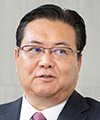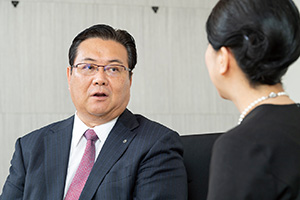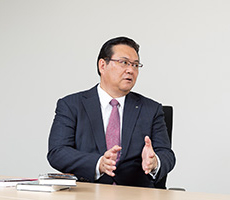 |
|
|
|
|
|
View from the Top Vol. 17, No. 2, pp. 1–5, Feb. 2019. https://doi.org/10.53829/ntr201902tp1  Boldly Taking the Helm to Be “Your Value Partner” Now and into the FutureOverviewInnovation in digital technologies is disrupting existing industries while creating new value. At the same time, social phenomena such as an aging population with a declining birthrate and a shrinking labor force continue to have a major impact on consumer lifestyles and corporate activities in Japan. NTT has formulated a digital transformation strategy in the face of such social issues. We asked NTT Senior Executive Vice President Motoyuki Ii, a driving force behind this strategy, to tell us how he plans to deal with these issues as Chief Digital Officer. Keywords: digital transformation, disruption, R&D Put employees at ease, accumulate small successes, and pursue bold changes—NTT Group’s Medium-Term Management Strategy has recently been announced. How do you plan to implement this strategy as Senior Executive Vice President and Chief Digital Officer? The theme of this Medium-Term Management Strategy is bringing about a major transformation in NTT and the NTT Group. There are four pillars making up this strategy, two of which promote our customers’ digital transformations and our own digital transformation. This is my mission as Chief Digital Officer (CDO). The position of CDO was newly established in August 2018 not only in the holding company but also in major NTT Group companies including NTT EAST, NTT WEST, NTT Communications, NTT DOCOMO, and NTT DATA. Each company’s CDO has the job of maximizing the use of data and information and communication technology (ICT) to revolutionize business processes and make human intervention minimal. In other words, each CDO has the role of bringing about a major transformation in management. Here, transformation means changing existing processes, or to put it another way, to disrupt the current way of doing things. There will naturally be some resistance from people who have been working in the same way for years, so to bring about a transformation, it is essential that a CDO “take the helm” with good negotiating skills and courage without yielding to that resistance. Although the original meaning of “D” in “CDO” is digital, it can also stand for disruptive, reflecting the role of the CDO as the person with ultimate responsibility for disruptive innovation. —A CDO takes on the heavy responsibility of overseeing a digital transformation, but to push such change through, won’t a good understanding of current conditions be needed? A CDO can also be appointed from the outside. That person would have to have a detailed knowledge of ICT and be proficient in business analysis, and should also be quite familiar with the way things have been done up to now. A company is a living thing, so it is essential that a CDO understand the present way of doing things and be able to establish a strategy for determining how things must change going forward. For this reason, the NTT Group is appointing CDOs from among people who have held responsible positions requiring an extensive understanding of business and work and who have much and varied experience in their backgrounds. On top of all this, a CDO must pursue major changes while accumulating small successes over big ones to put employees at ease. A “quantum leap” in the way things are done can be stressful for anyone, so employees are more likely to oppose such change than to give their approval. It is vitally important here to draw up a goal that everyone can commit to and to then move toward that goal one step at a time. To repeat, people are bound to show resistance to change, so a CDO must understand how to get employees to move forward to achieve transformation. That being said, I have been involved in all sorts of work since entering NTT about 35 years ago, including technology development, international procurement, plant planning, personnel affairs, NTT reorganization, and corporate sales, and I have experienced many successes and failures, all of which should serve me well as a CDO. The mission of a CDO is to promote the use of new technologies and systems to automate various types of business processes from a management perspective. It is precisely for this reason that a CDO who cannot grasp where manpower is realistically and specifically being applied will not produce effective results. As a CDO, I believe I can put my experiences in problem solving in many different areas to good use.
There is no such thing as unfinished work. The only recourse is to face a problem with resolve, honesty, and sincerity.—You said you have faced many situations involving problem solving, but can you tell us what area of your work taught you the greatest lesson? Let me tell you about a matter that I think I can call one of the biggest crises in my life. It occurred during the four years that I served as an NTT EAST senior executive vice president and head of corporate sales. It involved the use of digital technology to make a major change to the system of a certain university. We were using new technology that we were not yet fully adept at, and as a result, we missed the delivery date and were unable to achieve some functions we promised, all of which caused our customer a great deal of trouble. Repairing the system would require a period measured in years, and the whole project ended up in the red. Although this work involved collaboration with NTT Group system integrators and participating companies such as vendors, NTT EAST was the prime contractor, making us responsible for the project; we could not blame anyone else. In such a situation, the only approach was to be honest and sincere with the customer. Making excuses did not erase the fact that the problem was caused by a lack of technical competence and that the deadline could not be met. We gave the customer an honest assessment as to what efforts or measures we were taking, what problems still remained, and about how much time would be needed to rectify those problems. I took this action thinking that it was very important that I be viewed as an honest person and as someone who could be trusted. In addition, as leader of this project, I made an effort to cheer up and embolden members of my staff who were working for days on a major problem and being yelled at by the customer. This was truly a long battle that could not have been won without the strong bonds of a team that would not give up. Lost time cannot be recovered, so the only thing to do is move forward. Convinced that we could solve the problem and be accepted by the customer once and for all, all the members of this team confronted this situation with great resolve. It was a good opportunity to gain hands-on experience about learning from failure. —I can sense a terrible experience by just listening to your story. All of your challenging experiences should prove to be useful in your upcoming work. I believe that experience is the driving force behind one’s personal growth. It is important to have many experiences and make maximum use of them. However, the number of experiences one can have is limited, so reading can make up for that shortfall as pseudo experiences. Incorporating the experiences that others have had can deepen one’s knowledge, so I encourage my employees to read as many books as possible. I use as a reference the many conflicts that arose during Japan’s Muromachi period (1338–1573) and beyond when feudal warlords vied for political power, and I am also inspired by historical novels that depict peaceful times during the Edo period (1603–1867) when culture flourished. In particular, I find it deeply interesting how Hojo Soun established the foundation for the Hojo clan. Similarly, the Edo period originates with Tokugawa Ieyasu, Toyota Motor Corporation with Sakichi Toyoda, and Matsushita Electric Industrial Co., Ltd. (now Panasonic Corporation) with Konosuke Matsushita. Stories about people known as a chukonoso, who helped to make a corporation thrive, serve as a reference in my work. I also find books that make predictions about the future quite interesting. For example, I recommend “Homo Deus: A Brief History of Tomorrow” by the bestselling author Yuval Noah Harari, also known for “Sapiens: A Brief History of Humankind.” I also liked “The Singularity Is Near: When Humans Transcend Biology” by the American scientist Ray Kurzweil. Now 70 years old, Ray Kurzweil was placed in charge of developing artificial intelligence at Google six years ago. From these books, I learned that as science and technology develops, humans themselves will undergo dramatic changes as they assimilate those advances. This refers not only to the growth of humans as a species from the perspective of natural science but also to changes in individual humans due to science and technology that we ourselves created. Given the view that 2045 will mark a transition from Homo sapiens to post-humanism, it can be seen that we are living in a period in which mankind itself is undergoing a transformation. On taking charge of transforming the company in such a period and thinking about the best approach to changing the way we work and the role of the company, I feel that it is also necessary to consider the transformation in human beings. In this way, I think it’s important that we compensate for any lack of experience by putting the knowledge of trailblazers and researchers to good use in our work. One man alone cannot achieve a successful transformation, so I am taking up the challenge together with the CDOs of the other NTT Group companies. To begin with, we will undertake a transformation achieved through software and robotics by analyzing work processes and introducing ICT. However, making immediate and straightforward improvements to work processes will not be the end of our efforts. Our ultimate objective is to create an ecosystem in which work is completed without human intervention. I am beginning this endeavor by sharing a roadmap and goals among all CDOs. Perhaps there are some people who imagine that this is going to be a very difficult endeavor based solely on the documents describing these goals. Nevertheless, I would like to describe this dream in the form of specific goals and to consider how best to achieve them. I envision these goals to be achieved around the year 2050. In general, such plans for the future should be made, say, 100 years in advance, but as can be seen from the development of smartphones, technical innovation can bring about changes that occur too fast to predict. Taking such speed of technical development into account, I think we can set goals about 30 years in advance.
Supporting people who take on difficult themes and creating an appealing workplace for employees—What is “work” from your point of view? As I mentioned in my last interview (October 2016 issue), there is a difference between work and tasks. Work is making discoveries on one’s own and opening up new possibilities. Carrying out something that is simply given to you is not work. The action of thinking about what problems exist and what goals to set, and aiming for those goals are what constitutes work. Anything else we can regard as tasks. To put it another way, work is taking up the challenge of a more difficult theme and making an effort that can lead to results. I like the attitude of doing whatever it takes without giving up and making an all-out effort with not only the results in mind. If such an attitude can be maintained, some sort of achievement will be forthcoming. A theme can sometimes appear by chance, and some themes can be difficult to achieve, while other themes can be easy to achieve. It’s simple to evaluate things only based on the results, but I want to support those who do not avoid difficult themes but rather confront them head on. I am always telling those under me that such passion is what makes a company grow. I think that a person in top management cannot succeed without having skills in expressing one’s vision and without having decisiveness and courage. Although one method is to allow for proposals from subordinates in a bottom-up approach, I feel that presenting a clear direction from the top is one way of making it easier for subordinates to do their work. Failure to clearly indicate direction from the top forces subordinates to guess what that direction is and leads to a company on shaky ground. It is essential that top management take a bold stance in presenting direction. To execute that direction, it is necessary for subordinates to have the attitude in which they believe “I must think of another way to do this instead of giving a reason for not being able to do it.” There is no top executive who will listen to a reason for not being able to do something. For instance, with mountain climbing as an example, there are usually many paths to the top, so a good one can be searched for, and if by chance there are no paths, one can be created. A quick ascent may be possible if one is skillful, or a struggle may ensue. Either way, it is important that one does not give up on reaching the top. —Mr. Ii, what would you like to say to our researchers? To begin with, I’d like to point out that I am concurrently serving as Chief Technology Officer with the responsibility of establishing the NTT Group technology strategy, research and development (R&D) direction, and a strategy for determining how to apply our intellectual property to what kinds of services. In recent years, technology in the information technology field has been advancing exponentially. However, people tend to think of things in a linear manner, resulting in a gap with technology development. In this regard, a mainstay of NTT R&D has been the creation of intellectual property on its own. However, creating intellectual property in an independent manner may broaden that gap instead of closing it up. Therefore, I would like to ask researchers to be proactive in adopting a co-innovation approach, which means finding and incorporating intellectual property of value, integrating it with NTT’s own intellectual property, and creating new value. As I just mentioned, technology is advancing at an exponential rate, so I would like to promote co-innovation and new value creation so that we can ride the wave of technology development. Globalization is progressing not only in business but also in the field of R&D, resulting in a broadening of researchers’ activities. Amid this development, international headhunters have been targeting our researchers. In one sense, this is gratifying since it offers proof that NTT has superior, top-notch researchers. We are therefore revising our personnel system to persuade such top researchers to stay at NTT despite such invitations. At the same time, NTT is opening research laboratories outside Japan and establishing environments in which our researchers can work together with top international researchers. This represents a major change in direction for NTT R&D. In addition, opportunities for joint research are expanding with sites that promote cutting-edge research or so-called “crazy research” not only in Japan but also in Europe, the United States, and Israel. Such research activities can increase the appeal of NTT, and conversely improve the chances that NTT researchers are selected as partners in joint research. Achieving impressive research results is important, but what we also really want to do is to create an attractive company for researchers. —Finally, could you leave a message for all NTT employees? Yes, I would like to ask everyone to have a variety of experiences. Be curious about all sorts of things in relation to work and play. And by all means, read books to make up for what your experiences do not cover. The knowledge contained in books can inspire and enlighten you. When Internet searches leave you unsatisfied, you can find what you need in books. A book compiles the personal experiences and thoughts of the author, and as such, it can stimulate and motivate the reader. I believe that obtaining information and reading books are completely different worlds. Of course, it’s difficult to make time when you are busy, but life passes by quickly. I wouldn’t say one book a day, but if you can read one book a week, that would be about 50 books worth of inspiration a year. Please give it a try!
Interviewee profileCareer highlightsMotoyuki Ii joined Nippon Telegraph and Telephone Public Corporation (now NTT) in 1983. After becoming Manager of NTT EAST Niigata branch office in July 2007, he became NTT EAST Senior Vice President and concurrent Executive Manager of the Plant Department and Strategy Planning Department, Network Business Headquarters, in June 2011. He then became NTT EAST Senior Executive Vice President and Senior Executive Manager of Corporate Sales Promotion Headquarters in June 2016. He took up his present position in June 2018. |



